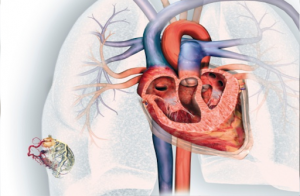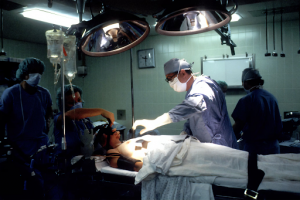Last updated on January 6, 2022
Content By: Dr. Nikita Toshi BDS, Assistant Manager (Medical Review), Dr. Ritu Budania MBBS, MD (Pharmacology) Head, Medical Affairs &
Last updated on January 6, 2022
Pericarditis is inflammation and irritation of the sac around the heart (pericardium). While this may sound quite daunting, this condition is usually treatable or goes away on its own. Sometimes the causes of the conditions remain unknown but there are a few key factors that may be the cause for this condition. Viral fevers, heart attacks and infections maybe a few of the causes of pericarditis. In a lot of cases, treatment of pericarditis includes bed rest or taking pain relief drugs to ease discomfort. Be sure to consult with your doctor if you experience any unusual symptoms or if you feel any discomfort.
This condition can occur at any age but it’s most common in adults aged 20 to 40 years old. However, children are prone to various types of infections and diseases, which can further give rise to pericarditis. Fortunately, there are many treatment of pericarditis options available for patients with pericarditis heart failure that will get them back on their feet quickly and easily!
This article will provide you with information about pericarditis, its causes, symptoms and treatment options. So, keep on reading.

Pericarditis is inflammation and irritation of the sac around the heart (pericardium). While this may sound quite daunting, this condition is usually treatable or goes away on its own. Sometimes the causes of the conditions remain unknown but there are a few key factors that may be the cause for this condition. Viral fevers, heart attacks and infections maybe a few of the causes of pericarditis. In a lot of cases, treatment of pericarditis includes bed rest or taking pain relief drugs to ease discomfort. Be sure to consult with your doctor if you experience any unusual symptoms or if you feel any discomfort.
This condition can occur at any age but it’s most common in adults aged 20 to 40 years old. However, children are prone to various types of infections and diseases, which can further give rise to pericarditis. Fortunately, there are many treatment of pericarditis options available for patients with pericarditis heart failure that will get them back on their feet quickly and easily!
This article will provide you with information about pericarditis, its causes, symptoms and treatment options. So, keep on reading.


Written by
BDS, Assistant Manager (Medical Review)

Reviewed by
MBBS, MD (Pharmacology) Head, Medical Affairs

Pericarditis is a rare inflammation of the pericardium (sac-like covering of the heart). It can be caused by an injury, viral or bacterial infection or fluid accumulation. While it is usually mild, some cases of pericarditis may occur suddenly and can last for several months. Pericarditis is generally non-life-threatening, especially in children but it may lead to complications if left untreated for a long period of time.
Pericarditis is a condition that affects both children and adults. In most cases, pericarditis in children results from viral infection or chest injury. However, it can also be caused by cancerous tumours within the chest cavity leading to pericardium fluid accumulation inside the pericardium layer of the heart sac, which compresses the surrounding nerves and blood vessels, causing pain. The diagnosis of pericarditis requires an ultrasound imaging test that will help doctors to determine the size of fluid accumulation and check for other possible conditions such as tumours.
Fortunately, most cases of pericarditis resolve spontaneously especially when it is caused by a viral infection or chest injury. treatment of pericarditis may include bed rest and pericarditis medication depending on the cause. In more serious circumstances your doctor may suggest surgery. So, do not delay seeking medical advice if you notice any acute pericarditis symptoms developing gradually over time.

Are you having acute chest pain?
Well, book a test at PharmEasy today to rule out your diagnosis.
There are many causes of pericarditis in adults. It is important to be aware of these pericarditis causes in order to determine the best treatment for pericarditis.
Viral/bacterial/fungal infections – The most common cause of pericarditis is a viral or bacterial infection. A person may get an infection of the pericardium layer from a respiratory infection, urinary tract or kidney infection. Also, if a person has an infection of the throat or sinuses, he/she may swallow bacteria that can infect the pericardium.
Respiratory infections – Respiratory infections caused by a virus may lead to viral pericarditis symptoms in some individuals. Respiratory infections are more common among adults and the elderly but respiratory infections can affect people of all ages. People who smoke are more likely to get respiratory infections than people who do not.
Autoimmune conditions like lupus, scleroderma and rheumatoid arthritis – These autoimmune diseases can affect the immune system, which is the body’s defence against foreign invaders like bacteria and viruses. When the immune system cannot tell between harmful “foreign” substances and healthy ones, it attacks both types indiscriminately which can lead to signs of heart inflammation or swelling in various parts of the body.
Digestive system infections – Pericarditis can develop after a gastrointestinal infection. In most cases, viral pericarditis develops as a complication to appendicitis or diverticulitis. In this case, the infection spreads from the appendix or intestine to the pericardium of the heart, leading to inflammation.
Heart surgeries – People who have undergone heart surgery are at a higher risk of developing pericarditis. If the patient is experiencing severe pain in the chest, it may be due to inflammation or swelling of the pericardium after undergoing procedures, such as coronary bypass grafting and valve replacement surgeries.
Kidney failures – People with kidney diseases are also at high risk of developing pericarditis. The kidneys help remove waste products from the body, so if they become damaged or diseased, it can lead to pericardium fluid accumulation in the chest cavity leading to pericardial effusion and eventually signs of heart inflammation.
HIV – People who are HIV positive may develop viral pericarditis. The reason is that when the immune system starts to fail in people with AIDS, it cannot fight against infections anymore and this makes them vulnerable to many different types of diseases, including bacteria or viral infections.
Cancer – Cancer-causing infections in the chest can also cause pericarditis. In this case, cancer cells migrate to the surface of the pericardium layers and lead to inflammation or swelling of the pericardium of the heart. This can lead to severe chest pain and difficulty in breathing.
Injuries from accidents/radiation therapy – People who have undergone radiation therapy of the chest area where the heart is located may develop pericarditis. In some cases, injuries from accidents or trauma to the chest can lead to inflammation and swelling of the sac around the heart.
Certain medications – Few medications that people take for treating certain conditions may lead to viral pericarditis. For example, a person who is taking blood-thinning medication (anticoagulants), such as warfarin or heparin, is at risk of developing swelling in the pericardium.

Worried about the causes of pericarditis?
Order these healthcare products from PharmEasy now.
The pericarditis signs and symptoms may not be noticeable in the early stages. The symptoms that are experienced by an individual who has pericarditis depend on the underlying cause. However, some common symptoms of pericarditis may include:
Chest pain – Acute left side chest pain can be a symptom of pericarditis in Indian patients. The chest pain associated with pericarditis may feel similar to that of a heart attack, but there are some differences between them that make it easier for doctors to distinguish one from another. Heart attack symptoms last longer and also include other signs like shortness of breath or feeling nauseated while pericardial chest pain lasts only for a few hours each time, along with general body weakness.
The intensity and the location of the chest pain may vary depending on what pericarditis is caused by. Sometimes, it may feel like a sharp stabbing sensation in between the shoulder blades (left side) and under the breastbone (centre). The pain may also spread to other areas like the neck, arms, back or jaw. In some cases, patients feel their skin over the centre of their chests become unusually tight. Chest pain causes and treatment should be taken care of as early as possible.
Swelling in the legs or abdomen – Swelling in the legs or abdomen is also a sign of pericarditis. This symptom occurs due to the accumulation of pericardium fluid around the heart and it can indicate that there is an underlying cause for inflammation, such as cancer or kidney disease.
Abnormal cough – The pericarditis patient may also experience an abnormal cough. This symptom is often associated with heart-related problems, so individuals who are experiencing this should talk to their doctor to get more clarity on their diagnosis.
Palpitations – An individual may feel their heartbeat more than usual or it could become irregular, particularly when they are resting. This symptom is known as “palpitation”.
Shortness of breath when lying down – Shortness of breath, especially when lying down flat, happens because the pericardial fluid accumulates in parts surrounding the lungs, making breathing difficult for patients with pericarditis.
Fatigue and weakness – Individuals suffering from acute pericarditis symptoms; tend to feel weak and fatigued easily due to low levels of energy production.
Low-grade fever – People with pericarditis may also experience low-grade fever, making them feel chills and shivers. This symptom is not dangerous but it can make the patient feel uncomfortable.
Other symptoms – Other less common signs of pericarditis include nausea, vomiting, loss of appetite and weight loss (cachexia) and sweating at night (night sweats).

People should consider seeing a doctor if they experience chest pain that lasts longer than 15 minutes or is accompanied by other symptoms like shortness of breath, fatigue and weakness. A pericarditis diagnosis should never be delayed.
Pericardial effusion in the heart is the buildup of fluid in or around the pericardium, which results in swelling and pressure on the heart. This increases venous return which is the volume of blood returning to your heart and also decreases cardiac output (blood pumped by your heart).
If a pericardial effusion condition occurs suddenly due to a large amount of fluid accumulation, then it can lead to cardiac tamponade, which is a condition in which blood or fluids builds up to fill the space between the pericardium and the heart muscle. As a result, tissue begins to malfunction, including our body’s cells that need oxygenated blood delivered by healthy circulation. Signs of cardiac tamponade include shortness of breath when lying down flat, fatigue and weakness despite a lack of any significant health problems.
In case you experience pericarditis signs and symptoms, then contact your doctor as soon as possible. This will prevent the condition from getting worse or affecting different parts of your body. In addition, if left untreated, pericardial effusion can lead to cardiac tamponade which is much more dangerous because it reduces blood flow through the pericardium layers even further leading to shock and ultimately death.

Do you notice any signs of pericardial effusion and cardiac tamponade?
If you do, then it's time for you to get the right medicines now from PharmEasy.
In India, doctors use several pericarditis diagnostic test methods to diagnose the condition. They include:
Chest X-ray – This allows doctors to see if the fluid is present in the pericardial sac. X-ray helps in identifying pericardial effusion and other signs of the condition.
Electrocardiogram (ECG/EKG) – This pericarditis test records the electrical activity in your heart to detect changes in your heartbeat that can occur if you have pericarditis pain. Simply put, ECG helps doctors understand how an individual’s heartbeats and its electrical activity over time by recording it on paper or digital screens.
Echocardiogram – This technique uses ultrasound waves to create an image of how much pericardium fluid is around or inside your heart. It is also helpful in understanding the risk of pericardial effusion and cardiac tamponade that may occur with the condition but it cannot confirm the presence of both conditions.
Chest CT scan – This pericarditis test creates multiple X-ray images taken from different angles to enable doctors to visualize structures within an organ like the lungs or heart more clearly than previously possible with conventional imaging techniques. During this procedure, doctors inject contrast material into your vein so they can see blood vessels on computer screens better. This enables them to identify inflamed pericardium layer and haemorrhage (bleeding) among other things related to pericarditis pain.
MRI scan – Magnetic resonance imaging uses powerful magnets instead of X-rays to produce images that appear brighter than regular X-ray pictures produced using radiation technology. By looking at MRI images of the pericardium, doctors can determine if it is inflamed or not.
Blood tests – Doctors may also ask for a blood test to rule out infections and other conditions that might be associated with pericarditis pain.

Experiencing symptoms of pericarditis?
Book a diagnostic test on PharmEasy to confirm your diagnosis today!

Depending on the severity of pericarditis, doctors may recommend treatment of pericarditis that can relieve symptoms and speed up the recovery process.
Pericardiocentesis – This is a minor procedure where doctors use needles guided by viewing instruments to withdraw the pericardial fluid from the pericardial sac. Pericardiocentesis may also provide relief in some cases if you are experiencing cardiac tamponade due to an accumulation of fluid in the pericardium. The procedure requires a short stay in the hospital and it is usually considered safe. However, there are risks associated with this procedure, which may include pain or difficulty breathing after the surgery that may require additional treatment of pericarditis. The patient may be under anaesthesia during the procedure and once it is completed, they may be monitored for a period of time.
Pericardiectomy – This is a surgical procedure where doctors remove all or part of the pericardium. It may provide relief in some cases by removing the source of excess pressure on your heart and lungs. Pericardiectomy can also be done through minimally invasive surgery but it still requires you to spend time at the hospital and it carries a risk of complications like cardiac tamponade and bleeding. Moreover, the recovery time is longer when compared to pericardiocentesis. This procedure is usually not recommended if you have a mild pericardial effusion.
In some cases, doctors may recommend non-invasive treatment of pericarditis to manage pericarditis pain in Indian patients. This includes using medications like anti-inflammatory drugs, corticosteroids and sodium channel blockers that can reduce inflammation around the heart, which is a common cause of pericarditis. The doctor may prescribe other medications like aspirin and beta-blockers that can provide relief from symptoms such as chest pain, shortness of breath or a racing heartbeat. Treatment largely depends upon the underlying cause.
The costs of treatment of pericarditis vary widely depending on the severity of the disease and your overall health. Most importantly, the cost will also be determined by which region you are getting the treatment at. It is important to note that some viral treatment of pericarditis can be quite expensive, especially if you are treated at a private facility or in an emergency room.
With that said, in a private hospital, surgical procedures may cost anywhere between ₹1.5 lakh to ₹2.75 lakh. In government hospitals, treatment of pericarditis is more affordable and ranges anywhere between ₹75,000 and ₹1 lakh.
After the treatment of pericarditis, your doctor may ask you to monitor certain things. For example, if you have undergone a surgical procedure like pericardiocentesis or percutaneous drainage of the pericardial fluid from around your heart, they might recommend regular follow-ups with them and their medical team.
Your doctor will probably advise that you take it easy for a while, which means avoiding strenuous activities. They may also ask you to avoid alcohol and smoking until your treatment is completed. This will reduce the risk of complications after surgery or other procedures.
While a pericarditis diagnosis or a treatment procedure can seem daunting, it’s always also good to be aware and prepared for the potential complications that may arise following treatment. They include:
Bleeding or infection post-surgery
Cardiac tamponade occurs due to the accumulation of pericardial fluid around your heart that can result in difficulty breathing and chest pain.
Other rare complications include blood clots as well as nerve damage due to improper placement of a catheter during pericardiocentesis, which requires immediate medical attention. If left untreated, it could lead to paralysis over time.
After the treatment of pericarditis, it is important to take good care of yourself. To prevent complications and recurrence of symptoms, you may need regular follow-ups with your doctor. You may also need to take pericarditis medications, prescribed by your doctors. It is important that you follow the doctor’s advice so as not to expose your heart and lungs to unnecessary stress. This especially means avoiding strenuous activities such as lifting heavy objects and smoking tobacco products like cigarettes or cigars.

Supplement your treatment with the right medicines!
Order online from PharmEasy and get it home delivered at your convenience.
Although there are many ways to prevent pericarditis, sometimes there is no way of completely avoiding it. Some cases of pericarditis such as those caused by infections and autoimmune disorders (HIV) can be prevented by treating those conditions, while some types of pericarditis, like those linked to the use of penicillin, can actually result from an allergic reaction or side effects. In such cases, it is important that you consult with your doctor about the safe usage of any medications you are taking.
Some ways you can keep yourself healthy and safe from any heart infections are:
Scheduling regular medical checkups and follow-ups with the doctor – If you have a family history of pericarditis or if your job requires you to be in contact with certain types of bacteria, chemicals or dangerous substances, make sure that you visit your doctor regularly. This will help them monitor any changes in the heart and identify early signs of infection before it spreads to other body parts. For instance, if you are exposed to pesticides or other harmful chemicals at work, make sure that you wear protective gear and always follow measures for safety when handling these products.
Upholding hygiene standards – Make sure that you maintain good hygiene levels and wash your hands often. This will help protect yourself from any bacteria or viruses, which could lead to an infection in the pericardium.
Avoiding stressful situations – If you suffer from chronic stress at work or home, make some changes for the better today. Regular exercise is a great way of keeping stress at bay. You can also try out yoga or meditation, as they are known to reduce the amount of cortisol in your body and improve blood circulation over time. Finally, make sure that you prioritize enough sleep (seven to eight hours per night) for a healthier lifestyle. Yoga, meditation and regular exercise are great ways to relax your mind and body from the daily stress of life.
Stay hydrated – Keep yourself well-hydrated by drinking plenty of water throughout the day. This will help keep you energized for all those household chores and errands. It will also prevent dryness in the pericardium, which is a common cause of infection and inflammation over time.
Eating healthy – What you eat also plays a big part in preventing pericarditis. Make sure that your diet contains plenty of heart-healthy foods like fruits and vegetables, whole grains, lean meats such as chicken and fish, nuts, low-fat dairy products like milk and yoghurt, beans and legumes (kidney beans), eggs, etc.
Lifestyle changes – Introduce a few changes in your lifestyle to lead a healthier life. For instance, if you smoke tobacco products like cigarettes and cigars, quit today and ask your doctor about safe alternatives such as nicotine gums and patches.
Taking care of your health and maintaining a lifestyle that benefits you will keep your body and mind in shape in the long run. It is always advisable to consult a doctor if you sense any discomfort that bothers you. Your health is your number one priority and prevention is always better than cure.

Protect yourself or your loved one from heart disease!
Explore a range of health care products on PharmEasy to boost your health!
The best treatment option for pericarditis will depend on the underlying cause of this condition, so please consult with your doctor about the most effective approach to managing it.
Pericarditis can go away within a few weeks or last for months depending on the underlying cause, so your doctor will likely keep you under close observation throughout this time period to ensure that no further complications arise in the pericardium.
Long-term effects of pericarditis may include a persistent pericardial effusion, a buildup of fluid in the pericardium that can cause further complications with heart function. However, this is not always the case and your doctor will help you determine if it applies to you or your loved one during regular checkups throughout recovery.
Pericarditis can cause severe pain that spreads to your shoulder or neck, which may become worse when taking deep breaths, coughing or standing up after lying down for an extended period of time. However, the severity and location of these symptoms will vary depending on the underlying condition affecting them. So, please discuss any additional discomfort with your doctor.
Pericarditis can cause damage to the heart over time but this will vary depending on the underlying cause of it in any given person or case. If you are experiencing symptoms that concern you after receiving your acute pericarditis diagnosis, please make an appointment with your doctor immediately for further guidance and assessment.
Untreated pericarditis can lead to severe complications and even death. So, it is important to improve your health with preventative measures, treatment of pericarditis and lifestyle changes like following the diet chart for heart patients and engaging in exercises for heart patients. For example, pericarditis that goes untreated over time may lead to the formation of scar tissue around the heart, known as constrictive pericarditis.


Leave a Comment